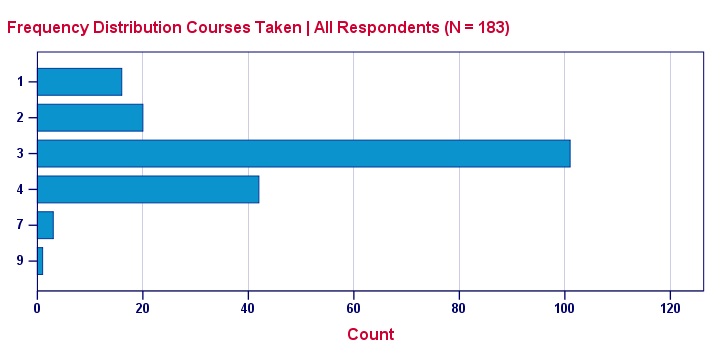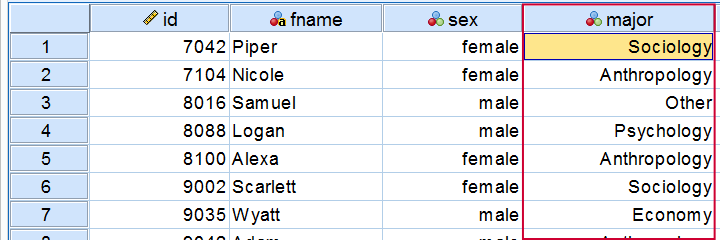Frequency Distributions Are Used to Describe the Relationship Between
Correlation coefficients were used to describe the relationship between total I-PSS and its components with the FV variables. Ann arranged her data into a distribution and then drew a graph called a histogram.

Frequency Distribution Quick Introduction
A grouping of data into mutually exclusive classes showing the number of observations in each class.

. When graphically depicting frequency distributions a _____ uses bars to display a frequency distribution for a quantitative variable. Although the frequency distribution provides information about how the numbers in the data set are distributed the information is more easily understood and. The 3 main types of descriptive statistics concern the frequency distribution central tendency and variability of a dataset.
Measures of central tendency give you the average for each response. Rather than construct the plot by hand we resort to a statistical software package. A frequency distribution is the organization of raw data in table from using classes and frequency.
When the design of a study utilizes a correlational method and to describe the strength of the relationship between two variables. True False Multiple Choice Questions 11. Distribution refers to the frequencies of different responses.
Cumulative relative frequency also called an ogive is the accumulation of the previous relative frequencies. The effect of patients quality of life score on I-PSS and FV variables was analyzed using regression. A frequency distribution for qualitative data groups data into categories and records the number of observations that fall into each category.
A frequency distribution is a table or graph that presents the categories or numerical values along with their associated frequencies. Which of the following methods best describe the relationship between two categorical variables. Frequency distribution is a way of organizing your data so that it makes more sense.
The volleyball team used 3 pairs of size 6 10 pairs of size 7 15 pairs of size 8 5 pairs of size 9 and 11 pairs of size 10. The number of miles that the employees of a large department store traveled to. Data values are grouped into classes of equal widths.
Measures of variability show you the spread or dispersion of your dataset. The smallest and largest observations in each class are called class limits while class boundaries are individual values chosen to separate classes often being the midpoints between upper and lower class. Figure 34 shows the relative frequency distribution of tumor sizes of 115 liver cancers.
To better describe how this works were going to review the difference between relative frequency and frequency. The distributions of FV variable scores within the categories of I-PSS severity were also examined. _____ can be used to study the relationship between two variables.
A frequency distribution is often used to group quantitative data. These tools are bar charts Figure 1. Riffenburgh in Statistics in Medicine Third Edition 2012 Probability of Certain Ranges Occurring.
Frequency distribution is a tabular or graphical representation of the data that shows the frequency of all the observations. It is a tabulation of the frequencies of each value or range of values. An _____ is a graph of a cumulative distribution.
This will throw more light on the different number of results that can be gotten from virtually any event at all. A frequency distribution is one of the most common graphical tools used to describe a single population. EXAMPLE 219 GRAPHING BIVARIATE DATA 71 Section 29 Graphing Bivariate Relationships Optional Suggested Exercise 2141 Solution.
_____ can be used to study the relationship between two variables a cross tabulation tables b frequency tables c cumulative frequency distributions d dot plots. Some common methods of showing frequency distributions include frequency tables histograms or bar charts. Data values are grouped into classes of equal widths.
A frequency table includes row and column percentages. In statistics the frequency distribution is a graph or data set organized to represent the frequency of occurrence of each possible outcome of an event that is observed a specific number of times. In an event we.
Let us denote mean by μ and standard deviation by σ for shorthand. A normal curve with the same mean 277 cm and standard deviation 101 cm is superposed. In a perfect positive relationship between two variables the.
Bars 3 4 5 gives you 22 13 8 43. A statistical technique for characterizing the pattern of a relationship between two quantitative variables in terms of a linear equation and for summarizing the strength of this relationship in terms of its deviation from that linear pattern. Chapter 2Frequency Distributions and Graphs.
In order to do this there are tools that are used to describe the frequency distributions of univariate variables. Ann could have created a relative frequency distribution as well. All of the following are used to describe quantitative data except the _____ a histogram b stem and.
The relative frequency of a category or a numerical value is the associated frequency divided by the total number of data. Use a scattergram to describe the relationship between the two variables of interest number of factors and length of stay. Graphical display that can be used to depict a frequency distribution.
A frequency distribution of data can be shown in a table or graph. Relative frequencies may be expressed in terms of percents fractions or decimals. There are a wide variety of ways to illustrate frequency distributions including histograms relative frequency histograms density histograms and cumulative frequency.
A frequency distribution counts the number of observations that fall into each of a series of intervals called classes that cover the complete range of observations B. To find the cumulative relative. Sometimes it may be useful to graphically present the relationship between two categorical variables.
Just like we use cumulative frequency distributions when discussing simple frequency distributions we often use cumulative frequency distributions when dealing with relative frequency as well. Explain the relationship between normal and lognormal distributions and why the lognormal distribution is used to model asset prices Distinguish between discretely and continuously compounded rates of return and calculate and interpret a continuously compounded rate of return given a specific holding period return. In case of a positively skewed frequency distribution the mean is always greater than median and the median is always greater than the mode.
If a frequency distribution graph has a symmetrical frequency curve then mean median and mode will be equal. Mean Median Mode Relation With Frequency Distribution. Cumulative Relative Frequency Distributions.

Frequency Distribution Quick Introduction


No comments for "Frequency Distributions Are Used to Describe the Relationship Between"
Post a Comment